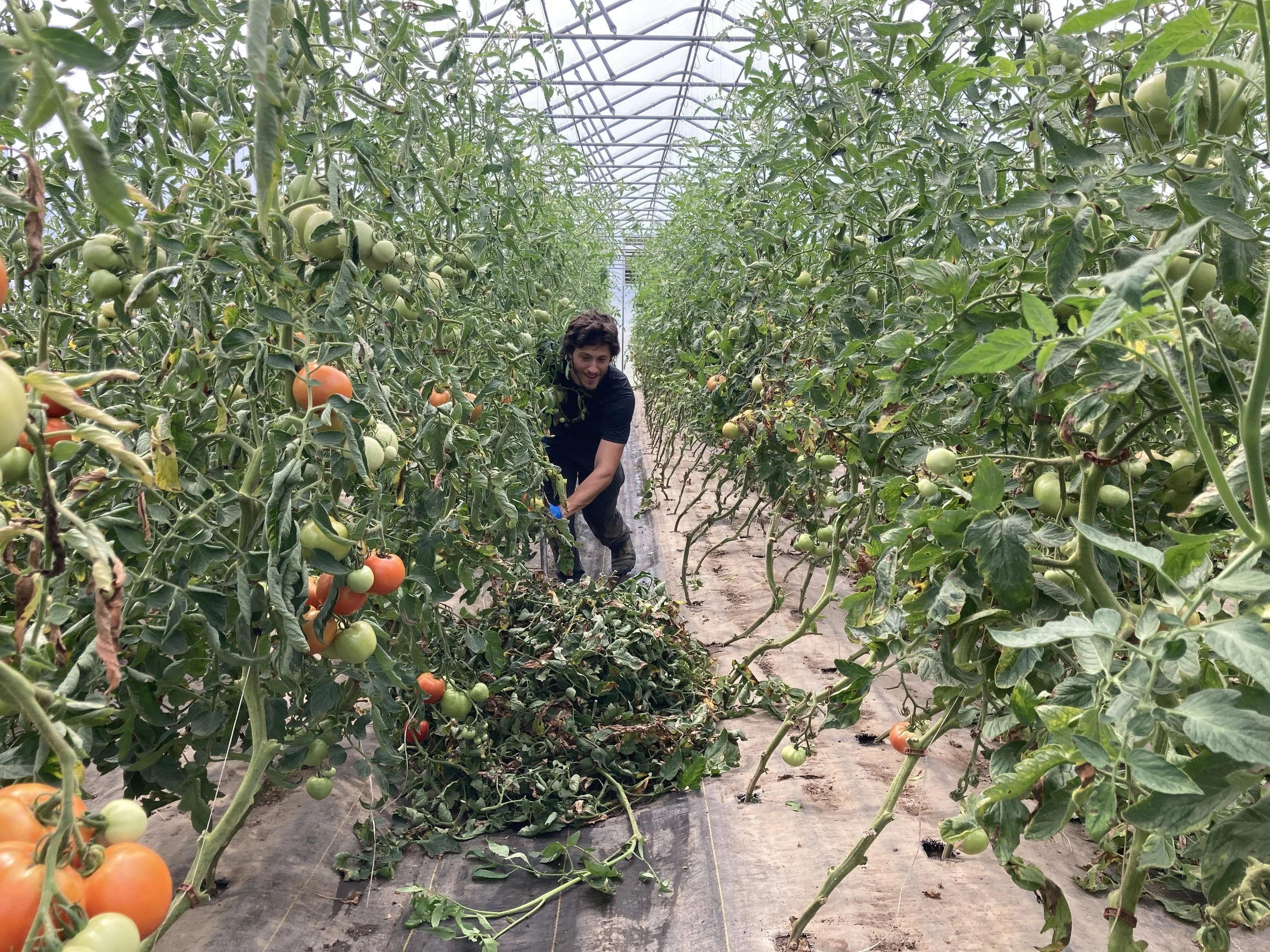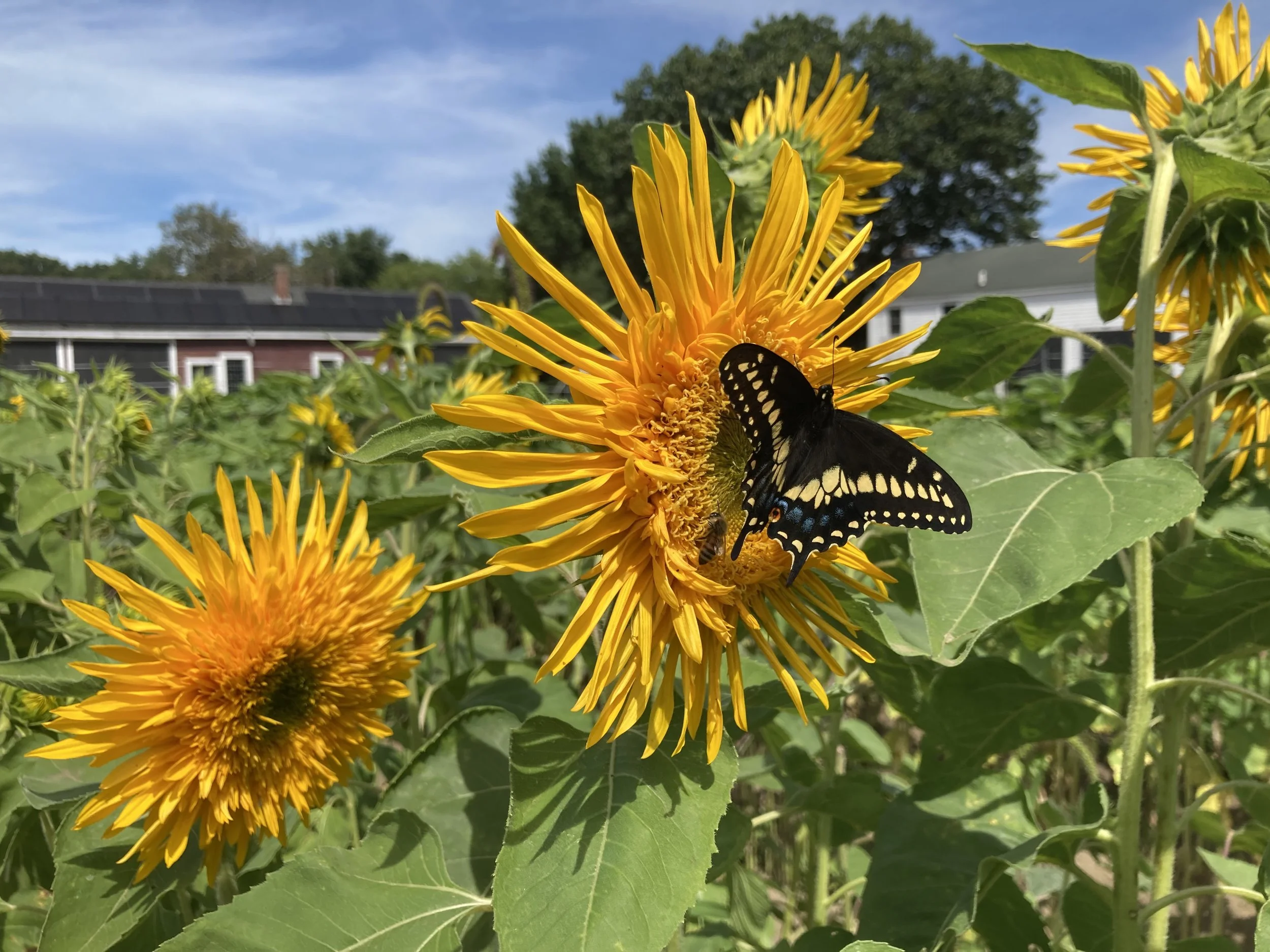Last week we worked on a bunch of high tunnel trellising and pruning. Tomato plants in particular grow fast in our high tunnel and require weekly trellising and pruning of new growth to maximize space usage and productivity. They are so tall now that we frequently require a step stool to clip the new growth to the trellising twine! The high tunnels are always warmer than out in the field, so with all the heat waves we tend to stay out of the tunnels after 10am. The crew are tough and well-acclimated to the heat, but 100+ degrees is a bit much for all of us! The heat poses a challenge to us keeping up with high tunnel maintenance, as we also have to get in much of the harvest before 10am in order to prevent wilting. The weather this week, however, looks great for getting into the high tunnels!
We’ve also been busy with weeding carrots and setting up and running irrigation. Fall carrots are a favorite, so taking care of them is a top priority. And irrigation is probably the most important priority - without water we wouldn’t have any crops this fall. Melissa and Maddie have been saving us during this drought, so if you see them around the farm, thank them for keeping everything well-hydrated!
In the CSA this week:
Spaghetti Squash - As it’s name indicates, the flesh of this squash is like spaghetti. Like all winter squash, it should not go in the refrigerator. This type of squash generally keeps for several weeks (so not as long as other varieties of winter squash). See below for directions for how to cook spaghetti squash squash, as well as a yummy recipe!
Asian Eggplant - We no longer grow eggplant ourselves, so these are from Silverwood Farm in Sherborn, MA. Certified Organic.
Colored peppers - We grow yellow, orange and red bell peppers, as well red Italian peppers in our high tunnel. The Italian peppers have thinner walls than the bell peppers and are sweet like colored bell peppers.
Green Peppers
Tomatoes - Mostly slicing tomatoes, but there may be some heirlooms mixed in as well.
Cucumbers - Our field slicing cucumbers are starting to produce more! We only plant field slicing cukes for late summer harvest because usually our high tunnel slicing cucumbers are plentiful through early August. However this year those high tunnel cukes got taken down by pests and disease quite early, so we’ve had to wait a little longer for larger quantities of cukes.
Watermelon - We are harvesting Mini Love and Blacktail Mountain varieties. Both are red with seeds. These will be available to both Small and Regular memberships.
Beets - These are grown by our friends Jenny and Bruce at Picadilly Farm in Winchester, NH and are certified organic.
Scallions
Lettuce
Endive and Frisée - We will mostly have endive, as we are nearing the end of out frisée plantings. The endive variety we grow has curlier leaves than Belgian endive and we don’t blanche the heads, so they actually look much more like frisee. Both are types of chicory and have similar flavors.
Mustard Greens or Arugula
CSA Pick-Your-Own:
Herbs: Members will have a choice of parsley, dill, dill flowers, sage, thyme, mint, and basil.
Hot peppers - choose from Jalapeño, Aji Rico, Cayenne, Hungarian hot wax and Fresno peppers. The cayenne and Hungarian hot wax are at the back of the hot pepper bed and there are lots to choose from! We also have some habañero ripening, which is what we’ll use to make hot sauce again this year!
Sunflowers- These are the fun Goldy Double variety. See the bottom of the post for a picture!
In addition, Regular memberships may choose 2 of the following, and Small memberships may choose 1 of the following:
Cherry Tomatoes - All varieties are ripening, but Cherry Bomb and Jasper (both red varieties) are particularly plentiful. The Sungolds got slammed by potato beetles early in the season, so we lost some plants and therefore don’t have as many available as usual. However we do have another orange variety called Citrine that is also delicious!
Tomatillos - They should be picked when the fruit fills our the green husk around it.
Dragon tongue beans - These have provided a longer than the green bean varieties we grow, but it will probably be the last week. As the dragon tongue beans get bigger start to turn yellow they can be shelled for cooking.
In the farm store:
Farm store hours are Tuesday-Friday 11am-6pm and Saturday 9am-3pm. We plan to have:
The following items that are also in the CSA: spaghetti squash, Asian eggplant from Silverwood Farm (starting Wednesday), colored peppers, green peppers, tomatoes, cucumbers, watermelon, scallions, lettuce, frisee, endive, herbs, hot peppers and tomatillos
Zucchini
Summer squash
Pickling cucumbers
Garlic
Potatoes
Shishito peppers
Flowers - sunflowers, wrapped mixed bouquets and snapdragons.
Peaches (starting Tuesday afternoon)- These will mostly be from Carver Hill in Stow, MA (not organic). They are harvested firm ripe, so they can keep refrigerated for a week and taken out to soften on your counter a day or two before you want to eat them.
Sweet corn from Verrill Farm (not organic) - This will only be available for the beginning of the week, but it should be back next week!
Mushrooms from Fat Moon Farm - Certified organic
Double B Honey - From hives on the property! Not certified organic
Applesauce from Long Run Produce in Boxborough, MA. Certified Organic.
Baer’s Best Beans: 1 pound bags. Grown in South Berwick, Maine. Certified Organic varieties available include: Cannellini, Black Turtle, Italian Cranberry and Light Red Kidney. Not organic: bumblebee, marfax, and flageolet.
PYO Flower Field
The flower field is open to both PYO Flower CSA members and the general public for picking by the jar. Please check in at the farm stand before picking. Flowers available for picking this week include: zinnias, snapdragons, gomphrena, ageratum, celosia, ammi, rudbeckia, verbena, amaranth, cosmos, decorative grasses, decorative basil and strawflower. There are also some sunflowers starting to bloom in the PYO Flower field!
How to Cook Spaghetti Squash
from Love and Lemons
Ingredients
1 spaghetti squash
extra-virgin olive oil
sea salt and freshly ground black pepper
Instructions
Preheat the oven to 400°F.
Slice the spaghetti squash in half lengthwise and scoop out the seeds and ribbing. Drizzle the inside of the squash with olive oil and sprinkle with salt and pepper.
Place the spaghetti squash cut side down on the baking sheet and use a fork to poke holes. Roast for 30 to 40 minutes or until lightly browned on the outside, fork tender, but still a little bit firm. The time will vary depending on the size of your squash. I also find that the timing can vary from squash to squash.
These are just basic instructions for how you can cook the squash. Once you have cooked it you can scoop out the spaghetti-like innards and add any toppings you might like with regular spaghetti! See below for an example of what you might do once it’s cooked.
Fresh Tomato Spaghetti Squash Pasta
By Erin Alvarez
Ingredients
1 medium spaghetti squash
1/4 cup olive oil, divided
2 garlic cloves, sliced
1 cup grape tomatoes
2 cups marinara sauce
1/4 tsp oregano
1/4 tsp red pepper flakes, or more
1 ball burrata cheese
Preparation
Preheat oven to 350°.
Slice squash in half length-wise and brush both sides with 2 tbsp olive oil. Place squash cut side down on a baking sheet and roast in the oven for 45 minutes.
After 30 minutes of the squash roasting, prepare the rest of the meal. Heat the remaining 2 tbsp olive oil in a large skillet over medium heat and add the tomatoes. Cook tomatoes for a few minutes, then add the garlic and stir. Continue cooking until tomatoes are blistered on both sides.
Pour sauce into the same skillet and heat it up until it's at your desired temperature. Stir in the oregano and red pepper flakes.
Once squash is done cooking, use your fork to pull back a few spaghetti strands, then divide the garlic, tomatoes and tomato sauce mixture between both sides of spaghetti squash. Add the burrata cheese on top, then add more red pepper flakes if desired.
Via Carota’s Insalata Verde
Adapted from Samin Nosrat, NY Times Cooking
Ingredients
Yield: 6 to 8 servings
2 - 3 heads lettuce
1 large endive
1 small head frisée
For the Dressing
1 large shallot, minced
2 tablespoons plus 1 teaspoon aged sherry vinegar, plus additional, as needed
1 tablespoon warm water
1 cup extra-virgin olive oil
1½ teaspoons Dijon mustard
1½ teaspoons whole-grain mustard
1½ teaspoons honey (optional)
2 sprigs thyme, washed and stripped
1 large clove garlic, finely grated
Salt and freshly ground black pepper
Preparation
Wash the greens: Fill a sink or large basin with tepid water. Remove any wilted or damaged leaves from the lettuce and endive. Trim each head at the root to release whole leaves. Halve large leaves of lettuce and endive on the bias, then drop into water. Trim and discard dark green outer leaves and tops from frisée until only light green and white parts remain. Trim at the root to release leaves, and drop into water. Swirl greens in water, then drain. Wash twice more in cool, then cold, water, then transfer to a salad spinner to dry. Gently wrap in clean dish towels, and set aside.
Place the shallot in a fine-mesh strainer, and quickly rinse with cold water. Allow to drain, then place in a medium bowl, and add vinegar and warm water. Allow to sit for 2 minutes, then whisk in oil, mustards, honey (if using), thyme, garlic and a large pinch of salt. Taste, and adjust salt and vinegar as needed.
To serve, gently pile a generous handful of greens into a serving bowl, then sprinkle with salt, pepper and a generous drizzle of dressing. Continue with another handful of salad and more seasoning and dressing, repeating until you have a glorious, gravity-defying mound of salad. Top with a final drizzle of dressing, and serve immediately.
Wrap remaining greens in an airtight container or plastic bag and refrigerate for up to 3 days. Cover and refrigerate remaining dressing for up to 3 days.
A butterfly and bee anjoy some nectar from a Goldy Double sunflower.


